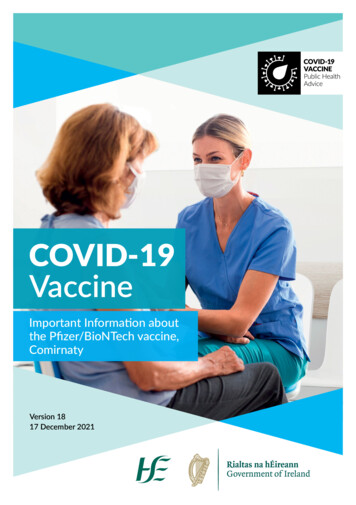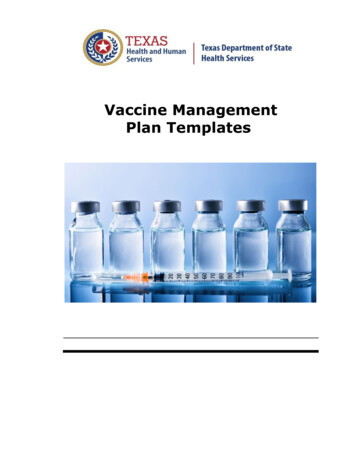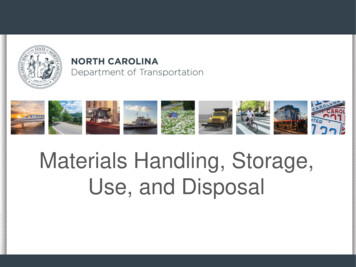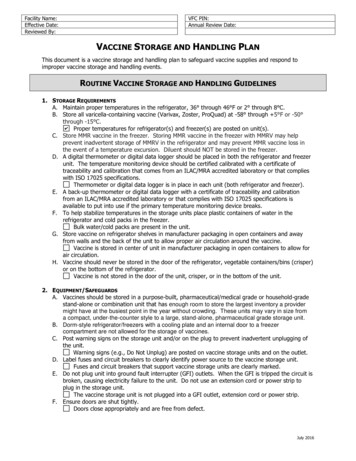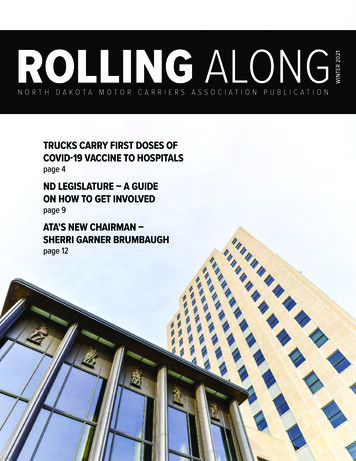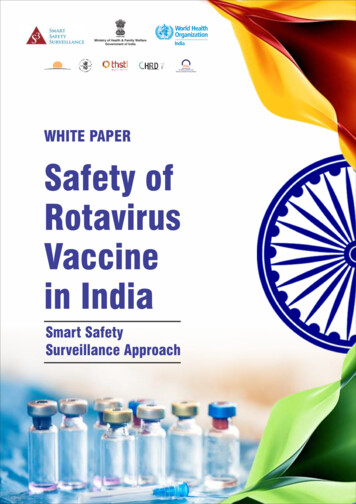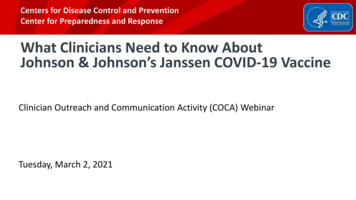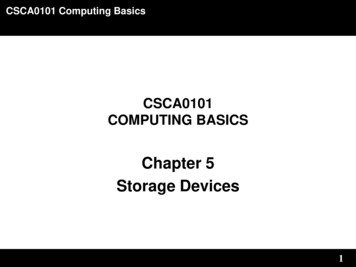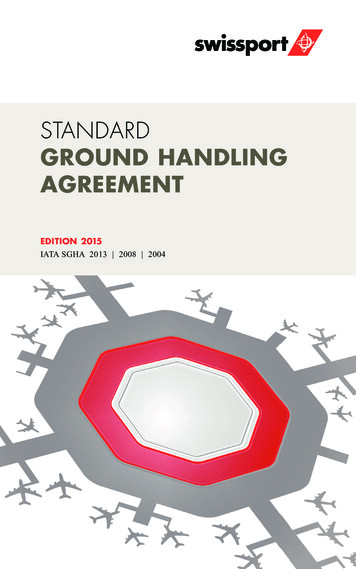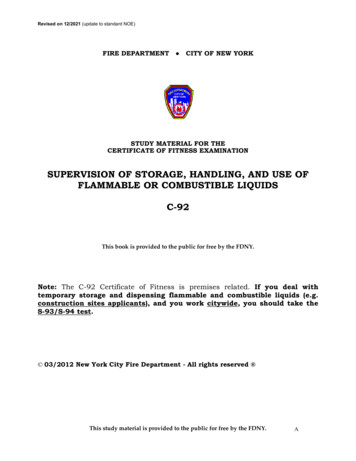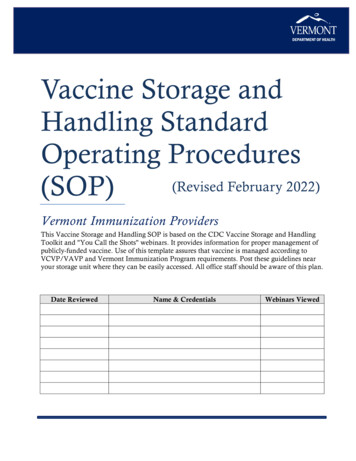
Transcription
108 Cherry StreetBurlington, VT 05402P. 802-863-7638E. AHS.VDHImmunizationProgram@vermont.govVaccine Storage andHandling StandardOperating Procedures(Revised February 2022)(SOP)Vermont Immunization ProvidersThis Vaccine Storage and Handling SOP is based on the CDC Vaccine Storage and HandlingToolkit and "You Call the Shots" webinars. It provides information for proper management ofpublicly-funded vaccine. Use of this template assures that vaccine is managed according toVCVP/VAVP and Vermont Immunization Program requirements. Post these guidelines nearyour storage unit where they can be easily accessed. All office staff should be aware of this plan.Date ReviewedName & CredentialsWebinars Viewed
Vaccine Storage and Handling SOPPractice NamePIN#Vaccine Coordinators (see page 3)NameTitle(e.g. RN, MA)Home and/orCell PhoneVaccineCoordinator:Back-upCoordinator:2nd BackupCoordinator (optional):COVID-19 Vaccine Coordinators (if different than above)NameTitle(e.g. RN, MA)Home and/orCell PhoneVaccineCoordinator:Back-upCoordinator:2nd BackupCoordinator (optional):Alternate vaccine storage location (see page 4)Location nameLocation addressPhonePrimary contact personoff-hours phone #Regional Immunization SpecialistNamePhone numberEmail addressahs.vdhimmunizationprogram@vermont.gov 108 Cherry Street Burlington VT 05402 802-863-7638rev. 02/20221 of 19
Vaccine Storage and Handling SOPSupplies Needed to Transport VaccineLocation on SiteSuppliesHard sided coolerFrozen Water BottlesCardboard and bubble wrapLog Tag Data Logger (see page 10)Person Completing This FormDate of completionYour NameTitleYour SignatureContact the Immunization Program at 802-863-7638 whenever there are changes.Additional Information (use as needed)Abbreviations:ACIP: Advisory Committee on Immunization PracticesMMR: measles, mumps, and rubella vaccineMMRV: measles, mumps, rubella, and varicella vaccineVDH: Vermont Department of HealthVCVP: Vermont Child Vaccine ProgramVAVP: Vermont Adult Vaccine ProgramVIMS: Vaccine Inventory Management Systemahs.vdhimmunizationprogram@vermont.gov 108 Cherry Street Burlington VT 05402 802-863-7638rev. 02/20222 of 19
Vaccine Storage and Handling SOPContentsI.Rationale.4II.Vaccine Emergency Management .4III.A.Temperature excursions .4B.Alternate storage location.5C.Emergency plan for a power outage .5D.SensoScientific alarm notifications .6Roles and Responsibilities .7A.Vaccine coordinators .7B.Other staff .7IV. Storage and Handling-Best Practices .7V.A.Selecting storage units (refrigerators and freezers) .7B.Preparing the unit for vaccine storage .8C.Vaccine transport (transfers) .9D.Backup LogTag data loggers .10E.Proper vaccine placement.10F.Avoid administration errors .11G.Temperature monitoring .11Inventory Management and Ordering Vaccine .12A.Vaccine ordering schedule .12B.VIMS and Vaccine ordering .12C.Receipt of vaccine shipments .13D.Avoiding wastage due to vaccine expiration .13E.Handling expired, spoiled, and wasted vaccine .14VI. COVID-19 Vaccine Storage and Handling .15A.Provider agreement .16B.Provider training .16C.Temperature monitoring .17D.Beyond Use Date (BUD).17E.Vaccine deliveries and inventory management .18F.Vaccine specific temperature guidance .19ahs.vdhimmunizationprogram@vermont.gov 108 Cherry Street Burlington VT 05402 802-863-7638rev. 02/20223 of 19
Vaccine Storage and Handling SOPI.RationaleProviders enrolled in the VCVP and state VAVP programs are entrusted with publicly fundedvaccine and must ensure viability. Vaccine that is not stored under required conditions may beineffective at producing an immune response. In 2021, the value of vaccine distributed to VCVPand/or VAVP enrolled practices in Vermont was more than 17,000,000.II. Vaccine Emergency ManagementA.Temperature excursionsIf you experienced a temperature excursion, contact the Immunization Program during thestandard business hours promptly by phone 1-800-640-4374 or emailAHS.VDHImmunizationProgram@vermont.gov. Do not move vaccine without approval.Place all vaccine of questionable quality on hold in storage(as if it is still viable), but do not use until guidance isobtained from the Immunization Program. Refrain frommaking assumptions about vaccine spoilage.Correct obvious problems. For example, if the door is ajar– close it; if the unit is unplugged – plug it in.Do not adjust the temperature control, add ice packs, orotherwise attempt to cool a refrigerator quickly, as thismay lead to overcompensation and freezing.Once an issue is resolved, acknowledge the alarm in thecloud system and note all actions taken. After an alarm isconfirmed, no further documentation is possible, so thisshould be the last step taken. (see section D for guidance).Reconcile your vaccine inventory in VIMS if it has beenlonger than 3 months.If it is after hours and youneed to use the vaccine beforethe next business day, or planto move the vaccine, dial thebelow number to to reachsomeone on-call.Otherwise, wait until the nextbusiness day.Immunization Program1-800-640-4374Failure to seek and followVDH guidance for vaccinestorage & handling ortransport may result invaccine loss.When a vaccine storage unit will undergo maintenance or repair, contact VDH in advance forinstructions regarding vaccine storage during the repair work.Never transport vaccine unless authorized by VDH Immunization Program Staff.Vaccine stored in the freezer is NOT usually transported.ahs.vdhimmunizationprogram@vermont.gov 108 Cherry Street Burlington VT 05402 802-863-7638rev. 02/20224 of 19
Vaccine Storage and Handling SOPB.Alternate storage location1. Determine a suitable backup location with a generator for vaccine storage in the event of amechanical or power failure. An extended power outage is defined as a lack of power formore than 2 hours.2. This location CANNOT be a private home. The unit must accommodate the amount ofvaccines currently in storage and meet the requirements outlined in this plan. Consult withthe management at the alternate site to assure your vaccine can be appropriately stored ifneeded.3. Permission from the Immunization Program is always required before moving statesupplied vaccine, even to your alternate storage location.C.Emergency plan for a power outageNEVER move vaccine to a home, another storage unit, or an approved location withoutpermission from the Immunization Program. In many cases, it is better to leave the vaccineduring a power outage rather than move it. If the building has lost electrical power, check with thebuilding maintenance or the power company to learn if a time for the restoration of power can bedetermined.1. During a short-term power outage (2 hours or less)o Do not open the refrigerator or freezer door until the power outage is resolved and thetemperature inside the unit is within the normal range.o If the outage occurs during business hours, note the time of the power failure.o Once power is restored, note the time and monitor temperatures (until it reaches 2 to8 C for the refrigerator, -50 to -15 C for the freezer).o Determine if the temperature has been out of range; if yes, contact the VermontImmunization Program.2. During a long-term power outage (greater than 2 hours)o Do not open the refrigerator or freezer door unless approval is requested and receivedfrom VDH to transport vaccines to the backup location. Even in the case of poweroutages over 2 hours, it is often preferred to leave the vaccine where it is.o If instructed to move vaccine to your alternate location: Contact the alternate location to ensure their power is functional and that they canstore vaccine. If they do not have power or enough space to store this vaccine,contact VDH for assistance in finding another location. Follow the instructions from the Immunization Program on packing andtransporting ownloads/emergency-transport.pdfo NOTE: Varicella (including both varicella and MMR-V) vaccines are highlytemperature-sensitive, and moving these is usually not permitted.ahs.vdhimmunizationprogram@vermont.gov 108 Cherry Street Burlington VT 05402 802-863-7638rev. 02/20225 of 19
Vaccine Storage and Handling SOPD.SensoScientific alarm notificationsAlarmMeaningDataAlarmTemperature Alarms whenis out oftemperaturesrange.are out of rangefor 45 minutes. Contact the Immunization Program.After the issue is resolved, log intothe cloud system and confirm thealarm under the Monitoring tab.SignalAlarmInternetconnectionhas beenlost. Wait 60 minutes for the connectionto reestablish. If it has been longerthan 60 minutes, contact theImmunization Program.After the issue is resolved, log intothe cloud system and confirm thealarm under the Monitoring tab.BatteryAlarmThebatteries arelow.ConditionsAction Required of Practice DuringNormal Business HoursAlarms whenWi-Fi is off for2 hours. Thedownloadsonce theconnection isreestablishedunless the datalogger is reset.Alarms whenbatteries needto be replaced. Action Required AfterStandard BusinessHours Contact the on-callperson for guidance ifyou need to use thevaccine before thenext business day orif you need to movethe vaccine.No action is requiredoutside standardhours of operation.If the network failedto reconnect, contactthe ImmunizationProgram the nextbusiness day.The practice is responsible for No action is requiredpurchasing replacement batteries.outside standardData loggers use four 1.5V AAhours of operation.Lithium Batteries. Replace the batteries If you need help with replacing theon the next businessbatteries, contact the Immunizationday.Program. Login to the cloud system under theMonitoring tab to confirm an alarmafter you replace the batteries.Audible Only if your audible alarm is enabled, then the data logger will sound off for the above noted reasons.AlarmPress the middle button to temporarily turn it off or log in to the SensoScientific cloud system to turnit off permanently.Do not suspend the alarm notification until the issue is resolved and the Immunization Program providesinstructions. Confirm the alarm only after the issue is resolved. Once a unit alarms, it will stayred until you confirm the alarm, even if the unit is reconnected to Wi-Fi, goesback into temperature range or the battery is replaced.ahs.vdhimmunizationprogram@vermont.gov 108 Cherry Street Burlington VT 05402 802-863-7638rev. 02/20226 of 19
Vaccine Storage and Handling SOPIII. Roles and ResponsibilitiesA.Vaccine coordinatorsDesignate a Primary Vaccine Coordinator and at least one Backup Vaccine Coordinator. Thispersonnel is responsible for managing state-supplied vaccine, as described in this plan. Bothshould be knowledgeable about vaccine management, and the Backup should be capable offulfilling all vaccine storage and handling requirements.When the Primary Vaccine Coordinator or the Backup is replaced, notify VDH so that therequired training can be scheduled promptly.Training: The Primary Vaccine Coordinator and Backup Vaccine Coordinator must complete thefollowing training annually if they did not receive a VCVP/VAVP compliance site visit for thecalendar year or if they were not present for the duration of the site visit.1. You Call the Shots: Module 10, Storage and Handling2. You Call the Shots: Module 16, Vaccines for Children Program [VFC providers only]Find the modules at mlB.Other staffAll staff with vaccine storage and handling responsibility should read and sign (on the cover page)this Vaccine Storage and Handling SOP annually and when changes are made to the plan.IV. Storage and Handling-Best PracticesA.Selecting storage units (refrigerators and freezers)1. Stand-alone refrigerators and freezers are strongly recommended over combination units.2. Combination refrigerator/freezer units must have separate doors and should have separatetemperature controls for each section. Use of such units is discouraged due to documentedproblems managing frozen vaccine and refrigerated vaccine in this style unit.3. Never Permitted: Dormitory or bar-style refrigerators. These are small combinationrefrigerator/freezer units outfitted with one exterior door and an enclosed freezercompartment.4. Freezero The freezer should be auto defrosting or .gov 108 Cherry Street Burlington VT 05402 802-863-7638rev. 02/20227 of 19
Vaccine Storage and Handling SOPo Stand-alone freezers are strongly recommended. NIST 1 studies have shown that thefreezer in a combination unit is unreliable for keeping frozen vaccines at the propertemperature.o Freezer temperatures must be maintained between -50 C and -15 C (-58 F and 5 F).5. Refrigeratoro Stand-alone refrigerators are strongly recommended. The refrigerated vaccine may bestored in a combination unit; preferably, the freezer section is not used.o Refrigerator temperature must be maintained between 2 C and 8 C (36 F and 46 F).6. Consider the following to determine what size unit is required:o The vaccine should not be stored in the door, crisper, or space created by removing thecrisper bins.o The vaccine should not be placed on the floor of the unit.o The vaccine should not be stored near a cooling fan or vent.o Keep vaccine at least 2-3 inches away from the walls, floor, and coils of the storagecompartment.o Place vaccine as centrally as possible in the unit to allow for air circulation.o Allow air space between each large package, block, tray, or bin of vaccines.o There should be enough room to accommodate the largest inventory of the year –typically during flu season (or back-to-school) – without over-crowding.o There should be space for water bottles marked "do not drink." (See B.2 below.)o If medications and biological materials need to be stored with the vaccine, they shouldbe placed below the vaccine on a separate shelf to prevent possible contamination.They should not impede airflow.o Keep vaccine away from cooling vents/fans if you use a combinationrefrigerator/freezer unit. Place water bottles in front of such vents, but don't block aircirculation.o Avoid the use of the top shelf of the combination refrigerator when possible.o Keep all vaccine vials/syringes in their original closed boxes, including opened multidose vials.o It is best to store each type of vaccine in a separate, labeled basket or tray. Meshcontainers are recommended over solid-sided ones because they allow for airflow. Ifsolid-sided containers are used, they cannot have a lid.B.Preparing the unit for vaccine storage1. Do not store food and beverages in a vaccine unit.2. Water bottles marked "Do Not Drink" can be placed in the refrigerator in the door, or onthe floor as a thermal buffer. If possible, condition water bottles prior to adding them.Place against the back and along the walls if possible.1National Institute of Standards and Technologyahs.vdhimmunizationprogram@vermont.gov 108 Cherry Street Burlington VT 05402 802-863-7638rev. 02/20228 of 19
Vaccine Storage and Handling SOP3. Frozen water bottles can be placed in the freezer as a thermal buffer. Place these in thedoor and on the floor, or along the back if possible4. A "Do Not Disconnect" notice must be posted next to every outlet where a vaccine freezeror refrigerator is plugged in. A second "Do Not Disconnect" sticker must be posted on ornear the corresponding circuit breaker. 2Unit ApprovalPrior to use for storage of vaccine, the unit(s) should be inspected by ImmunizationProgram staff and have at least 72 hours of in-range temperatures, as monitored by adata logger supplied by the Immunization Program.C.Vaccine transport (transfers)All vaccine transport must be pre-approved by the Vermont Immunization ProgramTransport involves the movement of vaccine over a short time frame and distance betweenproviders. The time needed to transport should be less than 8 hours, and vaccine should be placedin a stable storage unit as quickly as possible. Vaccines should only be transported when necessary(in an emergency or to ensure the use of vaccines that are about to expire). Frozen vaccine shouldnever be transported except in an emergency and with prior approval.Supplies each practice must have on-site to transport vaccines safely: Hard-sided container or Styrofoam Backup data logger (see section D) Frozen water bottles (that need to be conditioned before packing) Insulating materials such as corrugated cardboard and bubble wrap(enough for two layers per container)Follow instructions on packing and transporting refrigerated vaccine ds/emergency-transport.pdfInstructions on packing frozen vaccines for transport are provided during approval from theVermont Immunization Program.Never place vaccine directly on frozen water bottles or frozen ice packs.2These are available from VDH.ahs.vdhimmunizationprogram@vermont.gov 108 Cherry Street Burlington VT 05402 802-863-7638rev. 02/20229 of 19
Vaccine Storage and Handling SOPD.Backup LogTag data loggersBackup data loggers are required to be used if an on-site data logger malfunctions, during vaccinetransport, and for off-site vaccination clinics. The Vermont Immunization Program providesbackup data loggers to all VCVP/VAVP enrolled practices and the device location should bedocumented. For additional data loggers, contact the Immunization Program.Backup data loggers:- Document the location the Log Tag device and cradle are stored.- Ensure at least one computer has the current LogTag software /download/- For more information see the LogTag Data Logger Device User ice-User-Guide.pdfBackup data logger setup prior to use:1. Condition the glycol bottle to the appropriate temperature by placing it in thefridge/freezer.2. Once in range, you may package the vaccine according to instruction (see section C).3. Transport the vaccine.4. If the data logger stays in range for the entire length of transport, no furthercommunication with the program is needed.5. If the data logger goes out of range during transport OR it was never able to get into properrange due to time constraints, you MUST contact the program and report this as atemperature excursion.E.Proper vaccine placement*COVID-19 Vaccine Storage Conditions found in Section eezerDiluentDiluent Varicella MMRVVaccinesto storestore inin thetheVaccine tofreezer or refrigerator MMRFreezer is efrigeratorrefrigerator All others Diluents that are packaged with their vaccines (e.g. ACTHIB, Rotarix)must be stored in the refrigerator and should not be separated from thevaccine with which they are packed. Diluents that are packaged separately from their vaccines may be storedat room temperature or in the refrigerator, not in the freezer. Thisincludes diluents for MMR, MMR-V, and Varicella.ahs.vdhimmunizationprogram@vermont.gov 108 Cherry Street Burlington VT 05402 802-863-7638rev. 02/202210 of 19
Vaccine Storage and Handling SOPF.Avoid administration errorsoooooG.o Label each basket/tray with the vaccine type. Labels are available for printing uide/vaccine-storagelabels.pdfSeparate and label privately-purchased vaccine vs. state-supplied vaccine.Separate and label adult vs. pediatric vaccine.Mark the date a multi-dose vial is opened. It should be used through manufacturer'sexpiration date printed on the vial.Conduct a weekly inventory to ensure rotation of vaccines. Short-dated vaccine mustbe used first.Report vaccine administration errors to http://verp.ismp.org/Temperature monitoringo Thermometers: Storage unit temperatures must be continuously monitored using dataloggers purchased and installed by the Vermont Immunization Program.o Placement: The probe in glycol bottle must be placed centrally in the storage unit.o Calibration: Vaccine thermometers must have a current certificate of calibration. VDHis responsible for recalibration services.o Malfunction: If a data logger malfunctions call the Immunization Programimmediately.2. Each day the clinic is staffed, and for each vaccine storage unit:o At the start of each clinic day document min/max temperaturesi. If using Senso: log in to the SensoScientific cloud system, check off eachvaccine storage unit and click "Audit Node." This will time stamp themin/max and “sign” with the login account.ii. If using a non-Senso system (third party or a LogTag Data logger):Min/Max, time, and initials must be documented on paper or throughanother accessible system.o The refrigerator temperature must be between 2 C and 8 C (36 F - 46 F).o The freezer temperature must be between -50 C and -15 C (-58 F to 5 F).ahs.vdhimmunizationprogram@vermont.gov 108 Cherry Street Burlington VT 05402 802-863-7638rev. 02/202211 of 19
Vaccine Storage and Handling SOPStrive for 5 CThe refrigerator mustbe between 2 C and8 C.Strive for an averagereading of 5 C.V.A.Freezer temperatureThe freezer must be between -50 C and -15 C.ALARMTake action if the unit is alarming.Inventory Management and Ordering VaccineVaccine ordering schedule1. Each practice is assigned an ordering frequency with a 2-week window of time.2. If the practice runs out of vaccine before the next scheduled order, email AHSVDHImmunizationProgram@vermont.gov to discuss placing an additional order.3. If there is not enough space in your refrigerator or freezer to store vaccine as described inthis document, the unit is too small. Request an increased ordering frequency and considerthe purchase of a unit that can store the largest anticipated inventory.B.VIMS and Vaccine ordering1. VIMS is accessed through the Vermont Immunization Registry (IMR) found s-vital-records/registries/immunization.o Users who do not have IMR access, should contact IMR support at 888-688-4667.o Once logged in, Select "Vaccine Inventory Management System (VIMS)" from the leftnavigation menu.2. A step-by-step VIMS User Guide is available on the Immunization Program /files/documents/pdf/ID IZ vax orderingUser%20Guide.pdfo Flu vaccine: Flu vaccine is ordered by the Immunization Program for all practices,beginning the first week of Sept. Specific guidance will be provided annually in August.3. All vaccine orders are reviewed by the Immunization Program. Should adjustments benecessary, you will be contacted.4. Status and tracking information for vaccine orders can be checked using the View Historylink.ahs.vdhimmunizationprogram@vermont.gov 108 Cherry Street Burlington VT 05402 802-863-7638rev. 02/202212 of 19
Vaccine Storage and Handling SOPC.Receipt of vaccine shipments1. Most vaccines are shipped from McKesson Specialty Distribution. Freezer stable vaccines(varicella and MMR-V) are shipped by the manufacturer, Merck.2. Upon receipt of refrigerated vaccines, open the box and check the enclosed temperaturemonitoring card. If it shows that an out-of-range temperature occurred during shipping,mark the vaccine "do not use," immediately store it in the refrigerator and call McKessonSpecialty at 1-877-836-7123 the same day, for further instructions.3. Frozen vaccines are NOT packed with temperature indicators. Instead, they come with ashipper insert that identifies the allowable shipping time. Check the packing slip's shippingdate to determine how long the vaccines were in transit. If the shipment arrived beyond theallowed time, mark the vaccine "do not use", store it in the freezer, then call theImmunization Program.o The lid of the box contains diluent. Remove the diluent from the lid before you discardthe box. Diluent can be stored in the refrigerator or at room temperature, but not in thefreezer.4. Verify that the packing slip agrees with the content of the shipment. Date and sign thepacking slip and keep it for your records. Do not fax it to VDH.o If the shipment contents and the packing slip do not match, call the ImmunizationProgram the same day the shipment is delivered.5. Rotate vaccine stock within storage units to ensure that vaccines with the shortestexpiration dates are placed in a position to be used first.D.Avoiding wastage due to vaccine expiration1. Conduct a weekly inventory to ensure that vaccine with the earliest expiration date is usedfirst.2. Sixty to 90 days before expiration, if a vaccine is not likely to be used, contact theImmunization Program for assistance redistributing the vaccine to a practice that can useit. Immunization Program permission is required before moving state-supplied vaccine.3. Remove the expired or non-viable vaccine from the storage unit. Mark "Do Not Use".Always maintain the integrity of your vaccine stock by never swapping or borrowing dosesbetween state-upplied and private purchase vaccineahs.vdhimmunizationprogram@vermont.gov 108 Cherry Street Burlington VT 05402 802-863-7638rev. 02/202213 of 19
Vaccine Storage and Handling SOPE.Handling expired, spoiled, and wasted vaccineAll spoiled, expired, or wasted vaccines must be accounted for and reported to the ImmunizationProgram in VIMS. These doses are documented via an Adjust Request with an Adjustment Typeof Return or Waste.1. RETURN: Non-viable, unopened and intact state-purchased vaccine vials and syringesshould be returned to McKesson for federal excise tax credit.o All expired, or spoiled vaccines must be reported in a VIMS Adjust Request. Print theRequest to use as a packing slip.o The Immunization Program will review the request and, upon approval, UPS willemail the user a shipping label.o Upon receiving the shipping label, vaccine should be packed to prevent vial breakageand shipped to McKesson within six months of spoilage or expiration. Enclose theRequest print out as a packing slip.2. WASTE: Vaccines are considered wasted if they have been opened or damaged andcannot be administered to patients. These vaccines may not be returned and should bediscarded as medical waste.o Reasons for waste include: being drawn into a syringe but not administered, opened inerror, error in reconstitution, vaccine whose sterility has been compromised by the vialbeing dropped or broken or open multi-dose vials that have expired.o All wasted vaccine must be reported in a VIMS Adjust Request.o Dispose of wasted vaccine on site in a sharps container.The Immunization Program greatly appreciates and values the many significant contributionsof Vermont primary care practices in ordering, storing, handling, and administeringimmunizations to children, adolescents and adults.ahs.vdhimmunizationprogram@vermont.gov 108 Cherry Street Burlington VT 05402 802-863-7638rev. 02/202214 of 19
Vaccine Storage and Handling SOPVI. COVID-19 Vaccine Storage and HandlingCOVID-19 vaccine storage and handling guidance is changing rapidly. Always refer to thespecific Emergency Use Authorization for storage and handling information. Find these at themanufacturer websites listed bel
instructions regarding vaccine storage during the repair work. Immunization Program 1-800-640-4374 . Failure to seek and follow VDH guidance for vaccine storage & handling or transport may result in vaccine loss. If it is after hours and you need to use the vaccine before the next business day, or plan to move the vaccine, dial the
